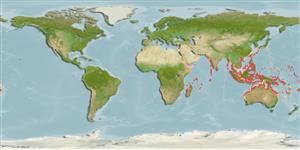Common names from other countries
>
Pleuronectiformes (Flatfishes) >
Bothidae (Lefteye flounders)
Etymology: Asterorhombus: Greek, aster = star + Greek, rhombos = paralelogram (Ref. 45335); cocosensis: Named for its type locality, Cocos Island (Ref. 57759).
More on author: Bleeker.
Environment: milieu / climate zone / depth range / distribution range
Ecologie
marien demersaal; diepte 1 - 30 m (Ref. 57759). Tropical
Indo-West Pacific: Mozambique to Fiji; north to Japan, south to Queensland, Australia (not occurring nonmarginally on the Pacific Plate).
Grootte / Gewicht / Leeftijd
Maturity: Lm ? range ? - ? cm
Max length : 12.0 cm SL mannelijk / geslacht onbekend; (Ref. 57759)
Dorsale zachte stralen (totaal) : 79 - 83; Anale zachte stralen: 59 - 64; Wervels: 35 - 36. This species is characterized by the following: body depth 51.5-58.3; sexual dimorphism
in interorbital width, in specimens approximately 6.0 cm SL, males 4.1-7.9, females 3.2-5.0; first dorsal-fin ray isometric relative to SL, with distinct membranous structure confined to tip. Pectoral fin count at the ocular side 10-13, blind side 8-11. The membranous structure at the tip of the first dorsal fin resembles a small fish or crustacean (possibly a small hippolytid shrimp), authors called the ray the illicium and the structure at the tip as the esca (Ref. 57759).
Found on pale sandy substrates in clearwater coastal bays to outer reef lagoons and sandy gutters on reef flats. Often crawls over low stony reef (Ref. 48637). The membranous structure at the tip of the first dorsal fin resembles a small fish or crustacean (possibly a small hippolytid shrimp), authors called the ray the illicium and the structure at the tip as the esca. The illicium waves the esca back and forth near mouth to attract prey. Shows sexual dimorphism in width of the interorbital origin, wider in males than females. Most frequently collected by divers.
Levenscyclus en paargedrag
Maturities | Voortplanting | Spawnings | Egg(s) | Fecundities | Larven
Hensley, D.A., 2005. Revision of the genus Asterorhombus (Pleuronectiformes: Bothidae). Copeia 2005(3):445-460. (Ref. 57759)
Status op de Rode Lijst van het IUCN (Ref. 130435)
CITES (Ref. 128078)
Not Evaluated
Gevaar voor de mens
Harmless
Gebruik door de mens
Tools
Speciale rapporten
Download XML
Internetbronnen
Estimates based on models
Preferred temperature (Ref.
115969): 24.8 - 29.3, mean 28.4 (based on 3223 cells).
Fylogenetische diversiteitsindex (Ref.
82804): PD
50 = 0.6250 [Uniqueness, from 0.5 = low to 2.0 = high].
Bayesian length-weight: a=0.00912 (0.00408 - 0.02036), b=3.05 (2.87 - 3.23), in cm Total Length, based on LWR estimates for this (Sub)family-body shape (Ref.
93245).
Trofisch niveau (Ref.
69278): 3.6 ±0.59 se; based on food items.
Weerstandsvermogen (Ref.
120179): Gemiddeld, minimale populatieverdubbelingstijd 1,4-4,4 jaar (Preliminary K or Fecundity.).
Fishing Vulnerability (Ref.
59153): Low vulnerability (10 of 100).
